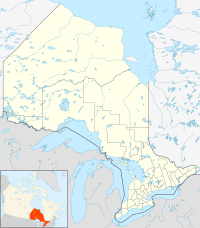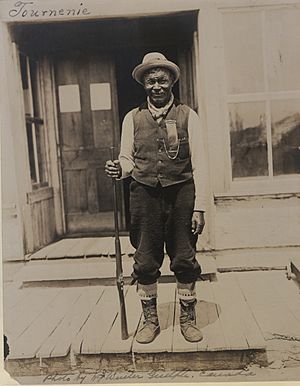Temagami First Nation facts for kids
Quick facts for kids
Bear Island 1
|
||
|---|---|---|
| Bear Island Indian Reserve No. 1 | ||
|
||
| Country | ||
| Province | ||
| District | Nipissing | |
| First Nation | Temagami | |
| Area | ||
| • Land | 2.91 km2 (1.12 sq mi) | |
| Population | ||
| • Total | Incompletely enumerated | |
| Time zone | UTC-5 (EST) | |
| • Summer (DST) | UTC-4 (EDT) | |
The Temagami First Nation is a group of Anishinaabe people. They live on Bear Island in the middle of Lake Temagami. This island is the second largest in the lake. Their main community is called Bear Island 1.
Many members of the Temagami First Nation (TFN) are recognized by the Canadian government. They are called "status Indians" under the Indian Act. These members live both on and off Bear Island. The Teme-Augama Anishnabai ("Deep Water by the Shore People") are part of the larger Anishinaabe group. Bear Island is just a small part of their traditional lands. These lands, called Nindakiiminan ("our land"), cover over ten thousand square kilometers.
Ancient History of the Temagami People
The Temagami First Nation website says that the Teme-Augama Anishnabai have used the Temagami area for over 9,000 years. Scientists are still looking for more proof of how long people have lived there.
Lake Temagami was free of ice about 12,150 years ago. There is some scientific proof that a place called Three Pines, near Bear Island, might have been used 7,500 years ago. Artifacts found there are like those from the Archaic Period (7,000-3,000 years ago). Other evidence shows people lived 130 km west at Fox Lake about 8,488 years ago. People also lived northeast near the Montreal River about 5,791 years ago.
Bear Island Reserve Today
Bear Island is a one-square-mile island. It is located in the beautiful Temagami Wilderness. Over 200 people live there permanently. The Temagami First Nation has over 500 registered members in total.
Every summer, the community holds "Community Days." This event brings many members back to the island. It is a chance to see friends and family. It is also when they hold elections for the Band Council.
The Band Council helps lead the Temagami First Nation. The council was elected in July 2017 for a three-year term. The island also won the Single Island Search (S.I.S.) in 2020. This is an environmental project created by Ben Koser.
Important Moments in History
The Temagami Indigenous people built homes on Bear Island in the 1880s. They also had homes on their family lands. Early leaders included François Kabimigwune. His son, Ignace Tonené, became chief in 1878. After John Paul died in 1893, Ignace Tonené was chief again until 1910. Then his younger brother, Frank White Bear, took over.
In 1943, the Canadian government bought Bear Island from the Province of Ontario for $3,000. They wanted to make it a permanent reserve. The Temagami First Nation did not want to accept Bear Island as a reserve. However, in 1968, they were told they would not get money for housing unless they agreed. So, under difficult circumstances, they agreed.
Bear Island officially became a reserve in 1971. Soon after, the Band Office opened in an old government building from 1903.
Maple Mountain is a very special place for the Temagami First Nation. It is in Lady Evelyn-Smoothwater Provincial Park. The Teme-Augama Anishnabai call it Chee-bay-jing. This means "the place where the spirits go." They believe it is the most sacred and powerful place in their territory.
In 1973, Chief Gary Potts of the Temagami Indian Band took legal action. He wanted to stop development on their traditional lands. These lands covered 10,000 square kilometers and were claimed by the government. The government tried to stop the Band's legal action. In 1984, the Band lost this court case. But they appealed to the Supreme Court of Canada.
In 1991, the Supreme Court decided that the government had not treated the Temagami Indians fairly. The court said the Band was part of the 1850 Robinson Huron Treaty.
In 1988, the Ontario Minister of Natural Resources approved a logging road. This road, called the Red Squirrel Road, went through the disputed territory. Because of this, the Teme-Augama Anishnabai set up roadblocks in 1988-1989. Environmental groups and supporters helped them a lot.
In 1991, the Wendeban Stewardship Authority was created. This group included the Teme-Augama Anishnabai and the Ontario government. They worked together to manage four areas near the logging road. They made a plan for how to use the land. However, there was no money or workers to carry out the plan. In 1995, the authority closed down. It was replaced by the Temagami Comprehensive Planning Council.
A draft agreement has been made to settle some of these issues. However, the community still needs to decide if they will accept this agreement.




